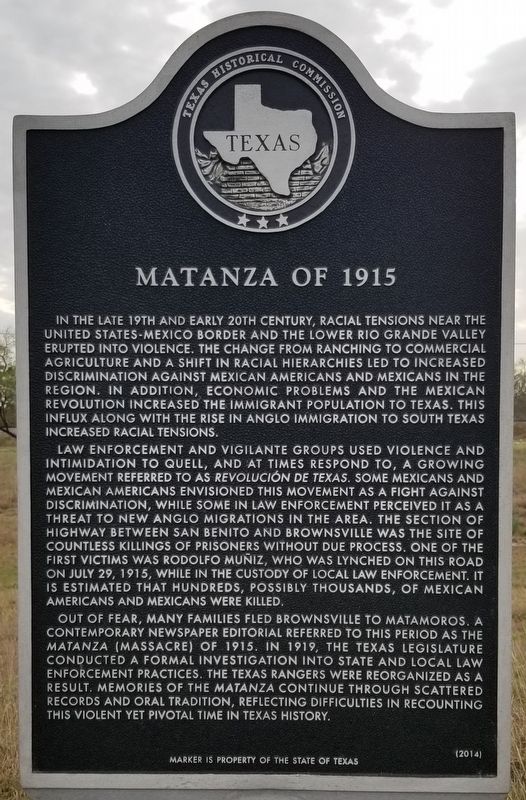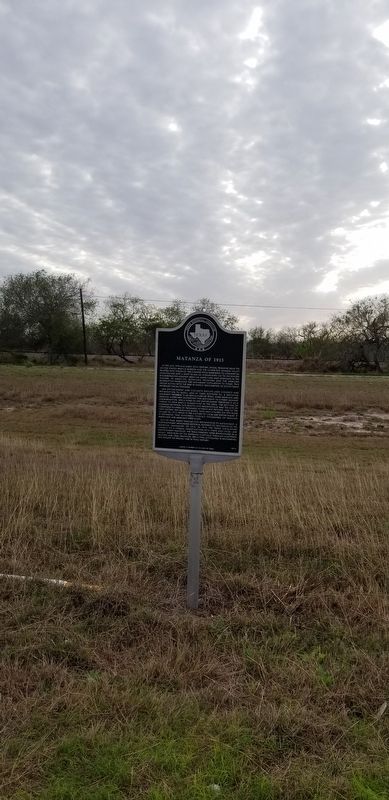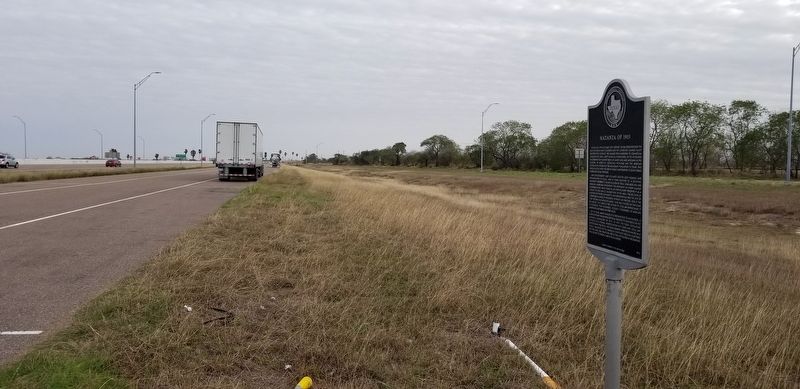Near San Benito in Cameron County, Texas — The American South (West South Central)
Matanza of 1915
In the late 19th and early 20th century, racial tensions near the United States - Mexico border and the lower Rio Grande Valley erupted into violence. The change from ranching to commercial agriculture and a shift in racial hierarchies led to increased discrimination against Mexican Americans and Mexicans in the region. In addition, economic problems and the Mexican Revolution increased the immigrant population to Texas. This influx along with the rise in Anglo immigration to South Texas increased racial tensions.
Law enforcement and vigilante groups used violence and intimidation to quell, and at times respond to, a growing movement referred to as Revolución de Texas. Some Mexicans and Mexican Americans envisioned this movement as a fight against discrimination, while some in law enforcement perceived it as a threat to new Anglo migrations in the area. The section of highway between San Benito and Brownsville was the site of countless killings of prisoners without due process. One of the first victims was Rudolfo Muniz, who was lynched on this road on July 29, 1915, while in the custody of local law enforcement. It is estimated that hundreds, possibly thousands, of Mexican Americans and Mexicans were killed.
Out of fear, many families fled Brownsville to Matamoros. A contemporary newspaper editorial referred to this period as the Matanza (Massacre) of 1915. In 1919, the Texas Legislature conducted a formal investigation into state and local law enforcement practices. The Texas Rangers were reorganized as a result. Memories of the Matanza continue through scattered records and oral tradition, reflecting difficulties in recounting this violent yet pivotal time in Texas History.
Erected 2014 by Texas Historical Commission. (Marker Number 18128.)
Topics. This historical marker is listed in these topic lists: Civil Rights • Hispanic Americans • Law Enforcement. A significant historical date for this entry is July 29, 1915.
Location. 26° 6.167′ N, 97° 35.882′ W. Marker is near San Benito, Texas, in Cameron County. Marker is on Interstate 69, 0.8 miles south of Sherer Road, on the right when traveling south. The marker is located at the southbound I-69 Rest Area. Touch for map. Marker is in this post office area: San Benito TX 78586, United States of America. Touch for directions.
Other nearby markers. At least 8 other markers are within 3 miles of this marker, measured as the crow flies. First Presbyterian Church of San Benito (approx. 2.9 miles away); All Saints' Episcopal Church (approx. 2.9 miles away); City of San Benito (approx. 2.9 miles away); The San Benito Bank and Trust Company (approx. 2.9 miles away); Water District Building (approx. 2.9 miles away); First Methodist Church of San Benito (approx. 2.9 miles away); Historic U.S. Post Office (approx. 2.9 miles away); San Benito Post Office (approx. 2.9 miles away). Touch for a list and map of all markers in San Benito.
Also see . . . La Matanza (1910–1920).
La Matanza ("The Massacre" or "The Slaughter") and the Hora de Sangre ("Hour of Blood") were a series of attacks and lynchings of Mexican ethnics by white Texans between 1910 and 1920 in the midst of tension between the United States and Mexico during the Mexican Revolution. These violent acts and killings were committed by Texan vigilantes and law enforcement, such as the Texas Rangers, during their operations against bandit raids known as the Bandit Wars. At least 571 Mexican Americans were lynched between 1848 and 1928, 20% of whom were lynched in the 1910s; in total, an estimated 5,000 Mexican Americans were killed during this period. Source: Wikipedia(Submitted on February 16, 2021, by James Hulse of Medina, Texas.)
Credits. This page was last revised on February 17, 2021. It was originally submitted on February 16, 2021, by James Hulse of Medina, Texas. This page has been viewed 2,088 times since then and 367 times this year. Photos: 1, 2, 3. submitted on February 16, 2021, by James Hulse of Medina, Texas. • J. Makali Bruton was the editor who published this page.


